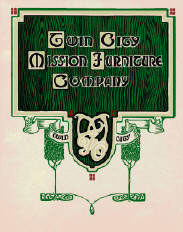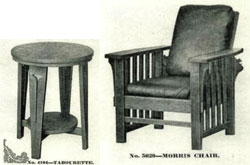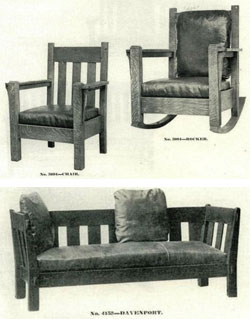Small Home Gazette, Spring 2013
The Twin City Mission Furniture Company
A Brief History
Editor note: On April 7, 2013, the Twin Cities Bungalow Club sponsored a presentation by publisher and Bungalow Club member Peter A. Copeland, who spoke about Arts & Crafts furniture companies of the Midwest. One of the three companies Copeland covered in detail was our own Twin City Mission Furniture Company. You may purchase a reprint of a rare 1911 catalog issued by the company from Copeland’s business, The Parchment Press, at www.turnofthecenturyeditions.com.
Arts & Crafts, or mission style, furniture was so popular from 1900 to about 1920 that hundreds of companies around the country manufactured this style of furniture at some time during this period. Along with Grand Rapids, Mich., and Chicago, Ill., the Twin Cities—and specifically the St. Anthony Park section of St. Paul—emerged as a regional furniture manufacturing center. The Twin Cities were experiencing rapid growth; there was good transportation and proximity to sources of lumber; and the area attracted a skilled labor force, many of them immigrants.
 The Twin City Mission Furniture Company was one of several companies that was launched in St. Anthony Park during the so-called “mission period.”
The Twin City Mission Furniture Company was one of several companies that was launched in St. Anthony Park during the so-called “mission period.”
In 1902, Fred C. Genge established a furniture manufacturing company on Hampden Avenue just across the street from the then-new Northwestern Furniture Manufacturers Exposition Building. The Genge company struggled financially at first, but it incorporated as the Fred C. Genge Company and recapitalized in February 1906. Soon it was advertising its mission furniture, seeking to capitalize on the enormous popularity of the style. A September 1906 advertisement urged consumers to buy its furniture because “Mission stands for the latest and swellest on the market.”
At some point between 1906 and 1908, the Genge company changed its name to the Mission Furniture Company, and in 1908, the name changed again to the Twin City Mission Furniture Company.

The Twin City Furniture Co. factory still stands at 2285 Hampden Avenue, St. Paul.
The Twin City Mission Furniture Company first appeared in the St. Paul city directory in 1909. Genge was not listed as an officer of the company, suggesting that ownership of the company changed around the same time that the name changed. The new company’s first president was Samuel H. Davis, and its first secretary/treasurer was Everett C. Fisher. In April 1910, the company obtained a building permit for a new factory across the street at 2285 Hampden Avenue. (The building is still standing and currently is under consideration as the site for artisans’ studios and more.)
 In 1911, following completion of its new factory, the Twin City Mission Furniture Company published a 68-page catalog of its offerings. Some of the company’s pieces consisted of furniture in the Tudor style—a mix of straight Arts & Crafts lines with old English round or turned-post elements. Most of the company’s production, however, was the familiar mission slatted chairs and rockers, settles, library tables, lamp tables, magazine stands, and footstools. Like much of the Arts & Crafts furniture of the period, the Twin City furniture was produced in quartered oak and upholstered in Spanish leather. Many of the company’s pieces were unremarkable in design, though they were economical and utilitarian. However, a few pieces in the catalog, such as Davenport No. 4153 and Table No. 5011, present interesting and relatively novel design elements. In its catalog, the company also touted its desire and ability to work with customers on custom and institutional furnishing plans. In fact, it is known that the company did provide furniture for a number of churches and other organizations in the Twin Cities area, among them Westminster Presbyterian Church in Minneapolis.
In 1911, following completion of its new factory, the Twin City Mission Furniture Company published a 68-page catalog of its offerings. Some of the company’s pieces consisted of furniture in the Tudor style—a mix of straight Arts & Crafts lines with old English round or turned-post elements. Most of the company’s production, however, was the familiar mission slatted chairs and rockers, settles, library tables, lamp tables, magazine stands, and footstools. Like much of the Arts & Crafts furniture of the period, the Twin City furniture was produced in quartered oak and upholstered in Spanish leather. Many of the company’s pieces were unremarkable in design, though they were economical and utilitarian. However, a few pieces in the catalog, such as Davenport No. 4153 and Table No. 5011, present interesting and relatively novel design elements. In its catalog, the company also touted its desire and ability to work with customers on custom and institutional furnishing plans. In fact, it is known that the company did provide furniture for a number of churches and other organizations in the Twin Cities area, among them Westminster Presbyterian Church in Minneapolis.
 The company seems to have changed ownership again around 1913 or 1914, when Benjamin Zimmer, a Minneapolis businessman, replaced S.H. Davis as president. In 1916, Benjamin Zimmer’s wife, Florence, became secretary of the company. The 1920 St. Paul city directory reported that the company had changed its name to the Zimmer Furniture Company (though it remained at the same Hampden Avenue address), reflecting not only the change in ownership of the company but also the fact that consumer demand for mission furniture had all but disappeared by 1920. The Zimmer Furniture Company continued in business for some time, but its glory days as a manufacturer of mission furniture were over.
The company seems to have changed ownership again around 1913 or 1914, when Benjamin Zimmer, a Minneapolis businessman, replaced S.H. Davis as president. In 1916, Benjamin Zimmer’s wife, Florence, became secretary of the company. The 1920 St. Paul city directory reported that the company had changed its name to the Zimmer Furniture Company (though it remained at the same Hampden Avenue address), reflecting not only the change in ownership of the company but also the fact that consumer demand for mission furniture had all but disappeared by 1920. The Zimmer Furniture Company continued in business for some time, but its glory days as a manufacturer of mission furniture were over.











